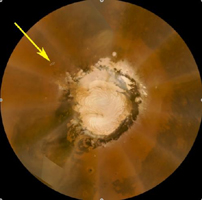
Image with ArrowScientists are anticipating clear skies when NASA's Phoenix Mars Lander arrives on the north polar plains of the Red Planet Sunday, May 25, 2008.
This orbital view of the north polar region of Mars, where NASA's Phoenix Mars Lander will land, shows clear skies as of May 22, 2008. Mission planners are always on the lookout for dust storms in daily weather updates like this one, provided by the Mars Color Imager on NASA's Mars Reconnaissance Orbiter. Based on current conditions, they are predicting good weather when Phoenix arrives May 25, 2008.
Temperature profiles, used to calculate atmospheric density, are also updated on a regular basis, provided by the Mars Climate Sounder, another instrument on the Mars Reconnaissance Orbiter. Atmospheric density was well within expectations as of May 22, 2008. Mission planners will continue to receive updates on weather and atmospheric conditions prior to landing.
The animated orbital view shows recent weather conditions from May 16 to May 22, 2008, as tracked by the Mars Color Imager on NASA's Mars Reconnaissance Orbiter. A cloud of dust kicked up by Martian winds traveled from west to east between May 19 and May 22, 2008, passing over Phoenix's landing site. The dust cloud was about 500 kilometers (300 miles) from head to tail and made the skies somewhat hazy. Since then, the dust has been replaced by clear skies, indicating that Phoenix will not land in any dust clouds, which are a common occurrence in the northern latitudes of Mars.
The Phoenix Mission is led by the University of Arizona, Tucson, on behalf of NASA. Project management of the mission is by NASA's Jet Propulsion Laboratory, Pasadena, Calif. Spacecraft development is by Lockheed Martin Space Systems, Denver.
Photojournal Note: As planned, the Phoenix lander, which landed May 25, 2008 23:53 UTC, ended communications in November 2008, about six months after landing, when its solar panels ceased operating in the dark Martian winter.

